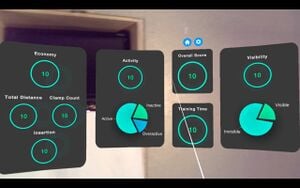
Self-assessment
- Smoothness of Movement — Acceleration, Hand Oscillation, Jolt, Clamp speed.
- Economy of Movement — Distance Travelled, Clamps count, Insertion of instruments
- Activity — Inactive, Active, and Overactive percentages; represented as a Pie Chart
- Visibility of instruments — Visible or Invisible
- Training time
Self-assessment of the quality of the skill acquisition must include some mechanism for targeted feedback which enables the user to: ensure they are practicing the appropriate skills; modify their performance to improve competence; and determine when they have practiced to a sufficient level of mastery to perform the procedure in a patient.
Methods[edit | edit source]
The methods we shall be using in the self-assessment framework are detailed as follows:
- Comparison of force signatures between novices, residents, and experts. We shall use the force signatures from experts as the comparison metric for novices and residents.
- We will be implementing advanced Artificial Intelligence (AI) technologies such as deep recurrent neural network models to predict the probable pitfalls during force and motion-based tasks.
- The AI-based framework will also be employed to classify the skill sets of surgical participants and predict the tissue damage at an early stage based on the history of force and motion parameters. Please also refer to Appendix I, where we explain the usage of AI in our modules in detail.
- We will provide Visual Feedback in the form of AR cues through a Head-mounted. Display on excessive force application and to combat misperception of self-applied forces.
- The movement time and index of difficulty based on the planned target and Region of interest (RoI) will be estimated.
- Impedance index of Novices, Residents, and experts shall be recorded and analysed to assess misperception.
- The economy of movements will be assessed. Usually, novice surgeons tend to be more nervous and hence will make unnecessary hand movements.
- The metrics to evaluate the effects of handedness (dominant and non-dominant hand) on both the fundamental and complex psychomotor force-based tasks will be evaluated.
- Due to the elongated instruments in Laparoscopy, there will be force transmission loss from the handle to the tip. This will be measured and presented to the surgeon in the form of cues.
- The evaluation of Transfer of Training score from the simulator to the operating room will be detailed.
- The Visual Focus and Attention Deficit assessment pertaining to whether the novice/resident is looking to the same RoI that the expert Surgeon is focussing on, will be included in the framework.
- The time taken to complete basic and complex tasks will be compared to metrics obtained from expert surgeons.
- Furthermore, metrics such as Just Noticeable Difference (JND), Coefficient of Force Variation, Peak First, Second, and Third order Force, Force derivatives, and velocity shall be used for assessment of the mastery level and also to differentiate the expertise levels of different groups of surgical participants.
- Learning curve shall be assessed at each stage of complex and fundamental tasks and will involve tracking of surgeons' projectile motion and path taken to reach the desired RoI, number of misses during knot tying process, excess pinch force exertion on tissue surface, and damage caused to neighbouring tissues.
- Haptic and force-based guidance mechanism to redirect the surgeon/novice to the desired area of interest. Reaction forces arising from virtual environments shall be measured and mapped back to the user.
- Both surgeons and residents shall be evaluated on force-based and psychomotor/motion/movement-based skill sets for box trainer-based simulation tasks and VR/ AR based haptic force-feedback tasks.